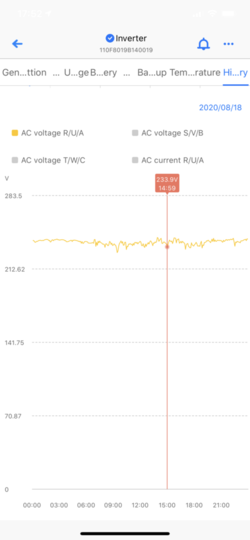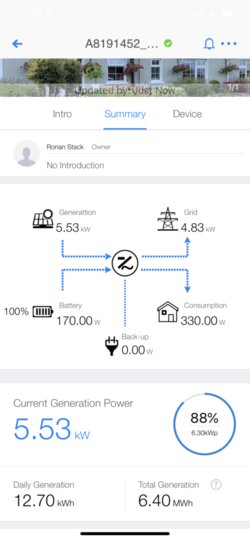RonanIrl: Thank you for the access to your solar PV system which I am studying. Could you confirm a couple of things for me please?
1. You have a generation meter in the ac line from the inverter to the mains intake which does indeed clock up kWh?
Yes ther is a meter in my Consumer unit that seems to just total generation since day one
2. Do you have a 'current clamp' attached around one of the electricity supplier's meter cables? It will look something like this:
Learn | OpenEnergyMonitor - https://learn.openenergymonitor.org/electricity-monitoring/ct-sensors/installation
It will be hard-wired back to the inverter or connected via a radio signal eg: Wifi.
I dont see one in the meter cabinet unles it is hidden away somwhere in the system betwene the meter cabinet and conumer cabinet possibly in the attic, im sure it is illegal to place anything in the meter cabinet on the network side of the meter as it owned by the network supplier
3. On your electricity bill is the debit amount of electrical energy you have to pay for the difference between your electricity supplier meter reading and your pv generation meter reading?
Not appicable as in Ireland we still dont get paid for surplus and no smart meters are installed yet..seems they are mandatory per EU law in 2021
4. On your bill is their a separate credit for surplus energy you have exported to the grid at a different rate to the units in para 3 - I wager there is not.
As above NA
Its appears to me that your pv system is set up to optimise 'self-consumption' of solar energy in real-time and if that cannot be achieved ie: your home's load is lower in kW than that being produced at the time by the panels to then store the excess in the battery for use at other times.
Because your backflow(ie: net )export power setting has been set to zero kW I think (need to confirm by studying more plots) that your system will never ever export solar panel power in excess of what can be consumed in real-time. So if your home load was say 1kW and the panel was producing 2.5kW and the inverter would offset the 1kW for the home load so there was no draw from the grid: and the excess of 1.5kW would be used to charge the battery. If the home load reduced to 0 kW the inverter would stop feeding 1 kW into the grid and the full 2.5kW would be used to charge the battery. However, once the battery is at 100% SOC any excess solar energy can no longer be stored in it; thus there can be the situation that there is no/next to no home load, high solar pv generation topping up the battery, the battery becomes full and all solar pv generation is terminated and the array current is deliberately reduced to zero Amps - or in other words pv generation ceases. It ceases because there is no where for it to be stored or consumed in the home and true export to the grid is forbidden by the backflow setting of +0000W. This is the 'self consumption' priority scheme.
Do i need to adjust the backflow setting?? if so what value?
To export surplus pv energy which you cannot store or consume in your home the scheme would have to be 'prioritise self-consumption and export/sell surplus'.
See for more explanation - you have the first set-up I reckon ;total self consumption any 'sale of excess' is prohibited at the moment by the backflow power being set at +0000W - you do have a generation meter for the reasons in para 3 above:
https://news.dualsun.com/news/lets-talk-about-pv-self-consumption/#:~:text=With%20%E2%80%9Cself%2Dconsumption%E2%80%9D%2C,meet%20the%20home's%20electricity%20needs.
Ok so that makes sense to me but i see power being exported all the time on my app for example today I was generating 5.23, battery was full 7KW and house only using 330W, eddi hot water heater was off as desired temp was met so rest was showing as flowing back into the network. If this was the case I wuld be getting faults alonmst daily in summer as my house has a very low load of 330W and high generation of 6.3KW max =-5%.
How do i change form self use to prioritise self-consumption and export/sell surplus' as you note above
Today was a great example it was super sunny loads of power, full battery, low house load and no heating water load and the system didnt switch off..seems to be heat related as the system will turn off if its also a warm day yet no alert codes on the inverter, maybe the installer is correct they are thinking the shunt is malfuctioning (switches off at over 70 degrees interbal temp) in the attic and shutting down hence sutting off grid access for power to escape. Attic owuld not have been more than 26 today but im guesisng can get higher in summr so that coupled with an inetrnal fault on the shunt could be the problem but im not sure.
This thinking - if correct - indicates why there have been no fault codes or alarms - it is the current mode of operation of your system for using and storing pv energy
to minimise your import of electricity from the grid.- but to make no gain from selling any excess
[automerge]1600102186[/automerge]
If you log in, go to Devices, click on the blue tick beside your inverter and then open the 'Status' you will see that 'Self-use mode' aka 'Self-consumption has been selected.













